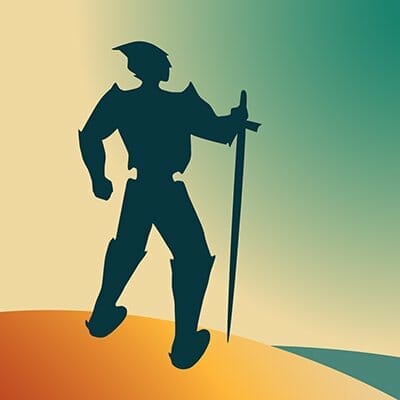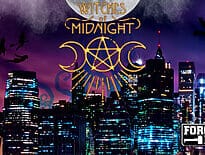Patrons, site supporters who chip in a few dollars a month, get to vote on an RPG publisher, creator or contributor each month to feature. This month the Spotlight has selected Lone Colossus Games.
It was great of Josh Rosing, the company’s founder and designer, to make some time and answer my questions.
There’s a lot of empathy here, and I’m especially listening to Josh’s comments about running a business in your spare time. Goodbye, spare time.
A Lone Colossus Games interview
Regular readers will know the format and that I’m not very advanced. Where do I start these things? Usually, I start at the start.
In the case of the RPG Publisher Spotlight, “starting at the start” means asking Josh some basic questions about getting started and the journey so far.
Who are Lone Colossus Games?
Just me! I rely a fair bit on freelancers though, especially for artwork since I am not an illustrator myself, as well as writers to expand the perspectives brought into my publications and fill the gaps I’m less comfortable with writing myself. Any writing I do also needs to be edited by someone else, because although I consider myself a good editor it’s almost impossible to do a good job editing one’s own work (especially when we’re talking about 100,000 words of game mechanics).
How did you get started?
As I was creating the systems and creatures for my home games that later became Injuries & Vile Deeds, I realized that the reasons I had for creating them were the same reason for many complaints I’d seen others make about 5e combat. That got me started thinking about the best ways to publish, and led me to start Lone Colossus Games in 2021. I spent several months putting out a free 5e creature each month, learning how to use social media and various publishing platforms, and preparing for my first Kickstarter. I also definitely had some inspirational motivation from hearing Matt Colville talk about his experience with publishing.
What have you learned on the way?
I’ve learned a lot, and I’ve learned that I still have a lot to learn. Running a business is a lot of work, and although I had an inkling of what that meant before I started I have a lot more appreciation for it two and a half years later. I’ve had to improve my time management skills (turns out running a business in your “spare time” really means “your spare time is consumed by running a business”), learn project management from the perspective of a business owner, develop knowledge of social media, marketing, and advertising, and, very importantly, learn to identify signs of burnout in myself before I get too close so that I can keep creating. I’ve also learned how incredibly fun it is to commission artwork and see a complete product come together!
What would you like to be best known for?
If there’s one thing I hope my work through Lone Colossus Games is known for, it would be products that inspire and encourage creativity and ingenuity from players. I love game mechanics, and a lot of my publications focus on mechanics that encourage specific modes of play – whether that’s the Injury systems and monster abilities in Injuries & Vile Deeds that drive tactical yet descriptive gameplay or the core system of Wyrmlings RPG that brings players together to use the power of friendship to overcome their challenges.
Is it good being bad?
Outside the tabletop RPG market, I wonder how many people are interested in books with tiles like Injuries & Vile Deeds, and would you invite them over for post-dinner games?
I had some unusual questions in my mind as I asked Josh about some contrasting directions.
What makes a good RPG product?
This is a really complicated question and I don’t know that I have a single answer for it since the answer depends on what kind of product we’re talking about. I’m a huge fan of settings getting setting-specific systems made for them because they can really, mechanically, immerse us in that setting. On the other hand, generic systems like D&D or Pathfinder are adaptable. We can write dozens of different settings that all work with the systems and as players we can easily move from one setting to another (generally fantasy settings for those two systems of course) without having to spend a lot of effort learning a new system.
Then there are supplements to existing systems – whether that’s a rules supplement, adding more enemies or character options, or providing new settings or adventures. We all know how chaotic adventuring parties are, and I personally find published adventures difficult to manage because they demand a certain amount of rails be applied to the game that I’m just not familiar enough with handling well (plus many of them make assumptions about standard settings that just don’t fit with my own, requiring me to rework them anyway). My favorite adventures, however, tend to provide the GM with knowledge about what will happen if the party does nothing – something I’ve recommended in the past when talking about how I prep for sessions.
I could probably talk about this forever and still not give a clear answer, but the last thing I’ll add here is that products should be properly edited and be given the time needed to make sure that the content will be fun to use. Plenty of mistakes are going to get through, and there’s no escaping that, but, as much as we as consumers might love looking at illustrations in a book, if the content isn’t usable because it’s poorly worded or improperly balanced then we aren’t really getting what we were promised.
Isn’t the Injuries & Vile Deeds concept a bit dark? What was the motivation for going there?
Absolutely. Especially compared with the high heroism that D&D rules tend to focus on, the supplement is very much oriented toward dark fantasy games and the dramatic fights found in shows like The Witcher or Castelvania. The core motivation was really the injury systems, which were my solution to the impracticality of mid to high level 5e combat. It’s not uncommon for PCs to emerge apparently unscathed from a fight that saw half of them knocked unconscious. On top of that, there’s a real dissonance between hit points and physical harm. For an NPC commoner or a goblin, it might be reasonable to say that if that character gets hit with a sword they probably really got hit – the blow maybe even killed them. But for most PCs (or any characters with a few dozen hit points that regularly take damage and heal completely with a night’s rest) it gets a lot harder to know how to describe combat. As players I think a lot of us really enjoy seeing the physical in-game effects of our actions, and adding injuries to 5e was a very direct way of doing that while also dealing with that dissonance – allowing us to keep our cool descriptions without tying it directly to hit points.
In terms of how dark the supplement gets at times, I personally love running and playing in dark fantasy settings. Being a hero is great, but it feels even better when the opposition is truly awful. And while it takes good group communication (something we should all be establishing regardless of the game we’re playing), having villainous characters in the party can make for some really amazing dramatic moments. My favorite campaign I’ve ever played in was actually a group of several evil characters. Some of us got to play through redemption arcs while others went on to become the main villains of the story, changing into NPCs at dramatically appropriate times.

In contrast, Wyrmlings, the Kickstarter you followed up with, feels more wholesome. Can you tell readers about that game?
Wyrmlings is a wholesome, all-ages TTRPG about young dragons going on adventures and overcoming challenges with their friends. It’s inspired by shows like Steven Universe and My Little Pony, and designed to be super low-prep so that a GM can run a session entirely on the fly if need be. I actually started writing this game after running a one-shot that became the adventure, Wyrmlings to the Rescue!, that’s one of more than a dozen pre-written adventures in the Wyrmlings RPG book. That one-shot was run with the Fate Accelerated system and was planned as a break from my usual games’ darker tone, but I found that the mechanics weren’t precisely what I wanted for the game I was running so I wrote my own.
I’ve run the game for a wide age range of players from 8 to probably upper 30s or early 40s and it’s been a blast every time. The game uses a 2d6 system that’s quick to pick up and grows in complexity as the player characters, “wyrmlings”, advance. Like most TTRPGs, characters have characteristics that get added to their dice, and then the dice are compared to a target number. In Wyrmlings, each die is compared separately, and the number of successes determines the overall outcome of the action.
I mentioned that the game is extremely low-prep, and the reason for that is that there are no stat blocks in the game. All a GM really needs is a plot hook and some pre-made characters (or a few minutes to take the players through creating their own characters) and they can get started. The book comes with a pair of introductory adventures as well that serve as a sort of tutorial, so the first time you sit down to play the game you can actually start playing right away without needing to read through a chapter of rules first.
The game encourages teamwork via a Help mechanic, in which one wyrmling provides physical or moral assistance to another member of their “brigade.” Each wyrmling can only help once per scene, so no single wyrmling (or player) can hog the spotlight for too long. Wyrmlings are better at helping if they have a good Friendship score, but they also use one of their other characteristics for the Help roll so if they’re helping with something they’re good at then they’re likely to succeed.
Yeah, but dragons…
I know they’re called Wyrmlings, but I’m a simple creature who thought of cute little dragons.
It’s not just geeky gamers who see particular creatures and use the word ‘dragon’ to describe them. I wondered if Josh had any insights on all these dragons everywhere.
Why do you think dragons have such a strong legacy and stories about them so often found worldwide?
I’ve read that dragons and other snake-like creatures are in so many cultures because snakes and other large predators were a significant threat to humans for a long time. I think it’s fascinating how the importance and meaning of dragons is so varied between each representation though. In pretty much every culture they’re creatures that should be awe-inspiring, but in some cultures they’re seen as more monstrous whereas others see them more as divine or wise beings. In terms of their existence in RPGs specifically, I think their existence in European folklore and the stereotypes of greed and dragon hordes probably made them a popular creature to include. The basic story of adventurers looking for gold and having to get past or slay a mighty creature pretty much writes itself with a dragon as the default horde-guarder.
How’s your stamina for dragons and fantasy in general now you’ve some Kickstarters under your belt?
I love fantasy and it’s probably the genre I’ll always return to. That said, I am also an engineer with a neuroscience background, and science fiction (especially cyberpunk and post-apocalyptic settings) are a real calling as well. I’m sure you’ll see a lot more fantasy-oriented books from me, but don’t be surprised if I occasionally put out sci-fi stuff like my Cyber//Core; HACK system!

How’s your stamina for Kickstarters? Now we’re on that subject, I wonder if they’re too much work or a fantastic way to realise projects that would only happen with them.
Great question! For sure, Kickstarters require a tremendous amount of effort, but at the same time it’s practically impossible for me to make fully-illustrated, edited, and laid out books without a lot more money than I’m able to provide on my own. Kickstarters have been a really fantastic way of finding out just how much interest there is in my work and determining how much I can invest in a given product. Larger projects also take a significant financial investment up front, so they still carry some risk even if it’s less than producing the entire product.
Lone Colossus but not alone?
I should remember to ask this question more often. There’s generally a ‘What’s next’ for publishers, and they don’t do anything in isolation, not even a publisher with a name like Lone Colossus Games.
There are next steps we can all take with Josh, the Wyrmlings and the RPG Publisher Spotlight winner in mind.
Is there anything fans can do to support Lone Colossus Games and perhaps hear about new projects first?
The best way to support me and Lone Colossus Games is to buy my products and review them! Producing books of the quality of Injuries & Vile Deeds and Wyrmlings is an expensive undertaking, and an ungodly amount of the resources you see raised in a Kickstarter goes toward the production costs alone. Reviews can really help others find my work, and also convince them to take the plunge and buy a book once they’ve found it, which helps drive the post-Kicsktarter sales that can provide more sustained income than crowdfunding campaigns.
If you’re looking to stay informed, I have a mailing list that I send a free map pack to each month in addition to any other important announcements. I also have a Discord server for those looking for more regular communication, or who just want to chat about games and get quick answers to questions. I’m also launching a Patreon for fans who want to get super-early access to material from upcoming products and get first looks at new artwork commissions. Patrons will also be able to make suggestions for pieces of content (depending on the book) that they want to see me make. Finally, I make regular posts on Twitter (@LoneColossus), Instagram, and Facebook (@LoneColossusGames).
What will Lone Colossus Games do next?
I have another 5e supplement planned that focuses on non-physical rewards for characters, including a lot of boons and blessings, as well as rewards for character growth like titles for accomplishing major achievements (like saving a city or defeating a major villain), and advanced trainings that encourage specific character builds that may be less usual or have a bit more difficulty to making them work. The supplement is planned to come to Kickstarter in either late 2023 or early 2024.
Lone Colossus Games
- Lone Colossus Games’ website.
- Lone Colossus on DriveThruRPG.
- Lone Colossus on Discord.
- Lone Colossus on Twitter.
- Lone Colossus on Facebook.
- Lone Colossus on Instagram.
Do you have any thoughts on this article?




